
Do you have a tax-favored strategy for retirement? Does it include a traditional IRA or a Roth IRA? Both have been around for decades, and the rules surrounding them have changed many times. What hasn’t changed is that they can help you save for retirement on a tax-favored basis. Here’s an overview.
Here’s the skinny on traditional IRA contributions
You can make an annual deductible contribution to a traditional IRA if:
- You (and your spouse) aren’t active participants in employer-sponsored retirement plans, or
- You (or your spouse) are active participants in an employer plan, and your modified adjusted gross income (MAGI) doesn’t exceed certain levels that vary annually by filing status.
For example, in 2022, if you’re a joint return filer covered by an employer plan, your deductible IRA contribution phases out over $109,000 to $129,000 of MAGI ($68,000 to $78,000 for singles).
Deductible IRA contributions reduce your current tax bill, and earnings are tax deferred. However, withdrawals are taxed in full (and subject to a 10-percent penalty if taken before age 59½, unless one of several exceptions applies). You must begin making minimum withdrawals by April 1 of the year following the year you turn age 72.
You can make an annual, nondeductible IRA contribution without regard to employer plan coverage and your MAGI. The earnings in a nondeductible IRA are tax deferred but taxed when distributed (and subject to a 10-percent penalty if taken early, unless an exception applies).
You must begin making minimum withdrawals by April 1 of the year after the year you reach age 72. Nondeductible contributions aren’t taxed when withdrawn. If you’ve made deductible and nondeductible IRA contributions, a portion of each distribution is treated as coming from nontaxable IRA contributions (and the rest is taxed).
Contribution allowances
The maximum annual IRA contribution (deductible or nondeductible, or a combination) is $6,000 for 2022 and 2021 ($7,000 if age 50 or older). Additionally, your contribution can’t exceed the amount of your compensation included in income for that year. There’s no age limit for making contributions, as long as you have compensation income (before 2021, traditional IRA contributions weren’t allowed after age 70½).
The finer points of your Roth IRA
You can make an annual contribution to a Roth IRA if your income doesn’t exceed certain levels based on filing status. For example, in 2022, if you’re a joint return filer, the maximum annual Roth IRA contribution phases out between $204,000 and $214,000 of MAGI ($129,000 to $144,000 for singles). Annual Roth contributions can be made up to the amount allowed as a contribution to a traditional IRA, reduced by the amount you contribute for the year to non-Roth IRAs, but not reduced by contributions to a SEP or SIMPLE plan.
Roth IRA contributions aren’t deductible. However, earnings are tax-deferred and (unlike a traditional IRA) withdrawals are tax-free if paid out:
- After a five-year period that begins with the first year for which you made a contribution to a Roth, and
- Once you reach age 59½, or upon death or disability, or for first-time home-buyer expenses of you, your spouse, child, grandchild, or ancestor (up to $10,000 lifetime).
You can make Roth IRA contributions even after reaching age 72 (if you have compensation income), and you don’t have to take the required minimum distributions from a Roth. You can “rollover” (or convert) a traditional IRA to a Roth regardless of your income. The amount taken out of the traditional IRA and rolled into the Roth is treated for tax purposes as a regular withdrawal (but not subject to the 10-percent early withdrawal penalty).
Be sure you know the specifics if your tax-favored strategy for retirement involves a traditional or Roth IRA. The knowledgeable professionals at Ramsay & Associates can help you understand the ins and outs. Contact us for more information about how you may be able to benefit from and save money for retirement with these types of accounts.






